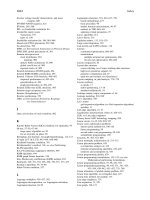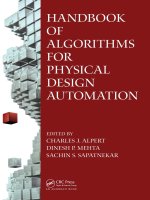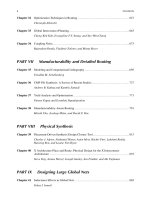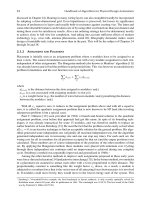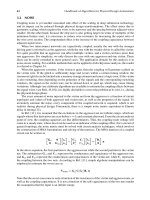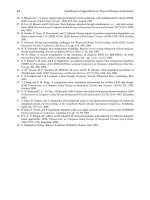Design and analysis of algorithms for solving some stochastic vehicle routing and scheduling problems
Bạn đang xem bản rút gọn của tài liệu. Xem và tải ngay bản đầy đủ của tài liệu tại đây (1.71 MB, 201 trang )
DESIGN AND ANALYSIS OF ALGORITHMS FOR SOLVING
SOME STOCHASTIC VEHICLE ROUTING AND SCHEDULING
PROBLEMS
TENG SUYAN
NATIONAL UNIVERSITY OF SINGAPORE
2004
DESIGN AND ANALYSIS OF ALGORITHMS FOR
SOLVING SOME STOCHASTIC VEHICLE ROUTING
AND SCHEDULING PROBLEMS
By
TENG SUYAN (B.ENG. M.ENG.)
A THESIS SUBMITTED
FOR THE DEGREE OF DOCTOR OF PHILOSOPHY
DEPARTMENT OF INDUSTRIAL AND SYSTEMS ENGINEERING
NATIONAL UNIVERSITY OF SINGAPORE
2004
ACKNOWLEDGMENTS
First and foremost, I would like to express my sincere gratitude to my
supervisors, Associate Professor Ong Hoon Liong and Associate Professor Huang Huei
Chuen, who provided patient guidance and constant encouragement throughout the
study and research process. I would also like to thank all other faculty members of the
ISE Department, from whom I have learnt a lot through coursework and seminars.
Special gratitude also goes to those colleagues who accompanied me and made
my stay in the Department pleasant and memorable. Particularly, I am grateful to Lin
shenxue, Gao yinfeng, Yang guiyu, Liu shubin, Yew Loon, Adam, Mong Soon, Liang
zhe, Ivy, who kindly offered help in one way or another. Also I would like to extend
my thanks to those whose names are not listed here, for their concern and help.
A special thank is for my mother who always cared and loved me with all her
heart.
This dissertation is dedicated to my husband, Mr. Wang zhidong, and my
daughter, Wang qing. They gave me all the love and encouragement when I was in the
low moments that inevitably occurred during the development of the dissertation.
Lastly, but not the least, I would like to thank my father, my parents-in-law and all
members of my family for their continuous encouragement and support.
––––––––––––
TENG SUYAN
i
TABLE OF CONTENTS
Acknowledgements i
Table of Contents ii
Summary vi
Nomenclature viii
List of Figures xi
List of Tables xiii
1 Introduction
1.1 Introduction to the Stochastic Vehicle Routing Problems ……………………1
1.2 Introduction to the Generalized Traveling Salesman Problem…………………4
1.3 Scope and Purpose of this Study……………………………………………….6
1.3.1 Scope and Purpose of Part I of this Study………………………………6
1.3.2 Scope and Purpose of Part II of this Study………………………………7
1.4 Structure of the Thesis………………………………………………………….9
2 Literature Review
2.1 General Overview of the Literature on SVRP…………………… …………11
2.2 Literature Review on Recourse Policies and Algorithms for VRPSD………17
2.2.1 Solution Concepts and Recourse Policies ……………………………17
2.2.2 Available Algorithms for VRPSD in the Literature ……………………20
2.3 Literature Review on the Generalized Traveling Salesman Problem…… …22
2.4 Conclusion and Further Remarks…………………………………………… 26
ii
3 Comparative Study of Algorithms for VRPSD
3.1 Problem Statement…………………………………………………………….29
3.1.1 Problem Description…………………………………………………….29
3.1.2 Calculation of the Expected Cost……………………………………… 30
3.1.3 Dynamic Programming (DP) Recourse Policy………………………….31
3.2 Review of the Selected Algorithms………………………………………… 33
3.2.1 Bertsimas et al.’s Algorithm………………………………………… 33
3.2.2 Yang et al.’s Algorithm……………………………………………… 34
3.2.3 Teodorovic and Pavkovic’s Simulated Annealing (SA) Algorithm……36
3.3 Common Grounds for the Comparative Study……………………………… 37
3.3.1 Criteria for the Measurement of the Comparative Study……………… 37
3.3.2 Building the Common Ground for Comparison ……………………… 37
3.4 Computational Results and Analysis………………………………………….41
3.4.1 Computational Results……………………………………………… 42
3.4.2 Performance Analysis of the Algorithms………………………………60
3.5 Summary and Conclusions……………………………………………………63
4 Metaheuristics for Vehicle Routing Problem with Stochastic Demands
4.1 Mtaheuristics for Single VRPSD……………………………… 65
4.1.1 Initial Solution and Generation of Neighborhood Solutions……………65
4.1.2 The Simulated Annealing and Threshold Accepting Algorithms……….66
4.1.3 The Tabu Search Algorithm……………………………… ………… 72
4.2 Simulated Annealing and Threshold Accepting Algorithms for Multiple
VRPSD 76
4.2.1 Generation of Neighborhood Solutions.……………………………… 76
4.2.2 Determining the Number of Vehicles and the Initial Solution … 77
4.2.3 Dealing with the Route Length Constraint…………………………… 78
4.2.4 The Procedure Involved in the SA and TA Algorithms……………… 78
4.2.5 Parameter Setting in the SA and TA Algorithms……………………….81
iii
4.3 Computational Results and Analysis………………………………………….82
4.3.1 Single Vehicle Routing Algorithms…………………………………… 83
4.3.2 Multiple Vehicle Routing Algorithms………………………………… 87
4.4 Conclusions……………………………………………………………………92
5 Algorithms for the Multi-period TCTSP in a Rolling Schedule Environment
5.1 Problem Description and Framework of the Study.………………………… 94
5.2 A Set-covering Type Formulation………………………………………… 96
5.3 Solution Method Based on Iterative Customer Assignment (ICA) Scheme 98
5.3.1 ICA Procedure.………………………………. .………………………100
5.3.2 Heuristics for the Assigning Procedure.……………………………….100
5.4 Solution Method Based on Iterative Center-of-Gravity (ICG) Scheme… 105
5.5 An Upper Bound Generated Based on the Set-covering Type Formulation and
Column Generation Solution Method……………………………………… 107
5.5.1 Column Generation Scheme… ………………………………. .…….108
5.5.2 Solving the Pricing Problem………………….………………………112
5.5.3 Procedure Involved in the Column Generation Scheme………….……115
5.6 Computational Results and Analysis….……… ……………………… 116
5.6.1 Problem Generation.………………………………. .…………………116
5.6.2 Compare the Performance of the Heuristics Against an Upper Bound 119
5.6.3 Performance Comparison Among the Heuristics.…………………… 127
5.7 Summary and Conclusions.………………………………………………….142
6 The TCTSP with Stochastic Travel and Service Times
6.1 Introduction………………………………………………………………… 144
6.2 Problem Description and Model Formulation……………………………….146
6.3 Valid Constraints Considered in the Integer L-shaped Algorithm………… 149
6.4 The Integer L-shaped Solution Method…………………………………… 155
6.5 Computational Results……………………………………………………….156
iv
6.5.1 Problem Data Generation………………………………………………156
6.5.2 Computational Results and Analysis………………………………… 158
6.6 Conclusions……………………………………………………………… 163
7 Conclusions and Directions of Further Research
7.1 Summary and Conclusions………………………………………………… 164
7.2 Main Contributions of This Study …………………………………………166
7.3 Directions of Further Research………………………………………………168
References………………………………………………………………………… 170
Appendix 183
v
SUMMARY
The classical traveling salesman problem (TSP) is the most studied combinatorial
NP-hard problem in the literature. This thesis addresses two variants of the TSP: the
vehicle routing problem with stochastic demands (VRPSD) and the time constrained
traveling salesman problem (TCTSP).
For the VRPSD, the problem is studied based on the formulation of stochastic
programming with recourse, which is within the framework of a priori optimization. A
comparative study among heuristics available in the literature is firstly carried out to
determine which one is superior to the others in a certain context; and valuable
suggestions and recommendations are made for decision makers in various scenarios.
Secondly, as most of the heuristics presented in the literature belong to classical local
search algorithms, the thesis proposes three metaheuristics: simulated annealing (SA),
threshold accepting (TA) and tabu search (TS), to examine whether metaheuristics are
more preferable for the VRPSD, and which metaheuristic is superior to the others in a
certain context. Computational results show that, metaheuristics can obtain solutions
with better solution quality for VRPSD, though they may consume more
computational time.
For the TCTSP, we first extend it into a multi-period problem: find a subset of
customers as well as the sequence of serving them in each period in a rolling schedule
environment, so that the average profit per period in the long run is maximized.
vi
Several heuristics based on iterative customer assignment and iterative
centre-of-gravity have been proposed for solving the problem. Then, the problem is
formulated as a set-covering problem and its linear programming relaxation is solved
to optimality by a column generation scheme to get an upper bound. To evaluate the
performance of the heuristics, for small size problems with long service time, the
heuristics are compared against the upper bound; for other cases, they are compared
among themselves. Computational results illustrate that, the best representative of each
heuristic performs very well for the problem, with the largest average percentage
deviation from the upper bound being 2.24%, and the smallest deviation only 1.02%.
When comparing the heuristics among themselves, results indicate that, with respect to
solution quality, each heuristic has its own advantage in a certain scenario. Decision
makers are advised to employ different heuristics in different scenarios. Secondly, the
TCTSP is further extended into the stochastic case, where the travel and service times
are assumed to be independent random variables. This extension is important because:
(a) Both travel and service times are not likely to be deterministic in the practical
situations; (b) The profit generated from visiting a subset of the customers is directly
affected by the travel and service times due to the time limit constraint. Again, within
the framework of a priori optimization, two models are proposed for formulating the
problem: a chance-constrained program and a stochastic program with recourse. Then
an integer L-shaped solution method is developed to solve the problem to optimality.
Results show that, the proposed algorithm can solve the stochastic TCTSP with
moderate problem size to optimality within reasonable time.
vii
NOMENCLATURE
SVRP Stochastic vehicle routing problem
VRPSD Vehicle routing problem with stochastic demands
SPR Stochastic program with recourse
TCTSP Time constrained traveling salesman problem
LP Linear programming
n Problem size - the number of customers
V {1, …, n} denotes a set of n customers
'V
V {0} denotes a set of nodes including customers and the depot ∪
A {(i, j) | i, j
and i < j} denotes a set of arcs
'V∈
c
i,j
Traveling distance between customer i and j.
m Number of vehicles
Q Vehicle capacity
D
i
A random variable that describes the demand of customer i
L A predefined maximum limit for the expected route length.
γ
i
The probability that the demand at the i
th
node is exactly equal to the
stock available in the vehicle
δ
i
The probability that the demand at the i
th
node exceeds the remaining
stock
q The vehicle’s remaining load
viii
p
i
(k) The probability that demand at node i is k.
q*(j) The threshold value for node j. If the remaining load after visiting node j
is less than q*(j), it is better to return to the depot before serving further
demand points.
0
t Initial temperature of a SA algorithm
f
t
Final temperature of a SA algorithm
α
Temperature reduction factor
ε
Thermal equilibrium factor
−
m
An upper bound for the number of vehicles m required
ϖ
Neighbor list size
π
An ordered sequence starting and ending at depot
)(
π
L
The expected route length of route
π
ρ
A positive parameter to penalize the objective function due to the fact that
the expected route length exceeds the predefined L
g
j
The date a customer j requires the service
j
σ
Tolerance time of a customer j
R
j
Profit of visiting customer j
H Number of periods in a rolling horizon
[e
j
, l
j
] Time window that customer j can be visited
p
ij
Profit of customer j if it is assigned to period i
ij
w
Weight of customer j if it is assigned to period i
T The effective working time for each period
ix
T
i
The remaining working time of period i
f
ij
A measure of the desirability of assigning customer j into period i
λ
Mean arrival rate of a Poisson distribution
G
i
(x, y) Center-of-gravity of the tour in period i
i
Ω The set of all possible sub-tours in period i
t
ij
A random variable representing time of traveling arc (i, j)
j
τ
A random variable representing service time of visiting node j
Maximum probability that total travel and service time of a tour is
allowed to exceed T
α
T
∆ Maximum amount of time allowed to exceed T
ξ
A vector of random variables corresponding to travel and service time
)(
k
ξθ
Total travel and service time of the route in excess of T when the
realization of the random variable is
k
ξ
k
ij
t
ξ
A random variable representing time of traveling arc (i, j) when the
realization of the random variable is
k
ξ
k
j
ξ
τ
A random variable representing service time of visiting node j when the
realization of the random variable is
k
ξ
β
The unit penalty cost for total time of the route in excess of T
η
A bound to estimate the expected penalty incurred for a given solution
x
LIST OF FIGURES
3.1 Expected Cost with the Increase of Problem Size
(Demands follow uniform distribution U[0, 20])
3.2 Computational Time with the Increase of Problem Size
(Demands follow uniform distribution U[0, 20])
3.3 Expected Cost with the Increase of Demand Mean and Variance
(Problem size n = 60)
3.4 Computational Time with the Increase of Demand Mean and Variance
(Problem size n = 60)
3.5 Expected Cost with the Increase of Problem Size
(Demands follow normal distribution N(30,25))
3.6 Computational Time with the Increase of Problem Size
(Demands follow normal distribution N(30,25))
3.7 Expected Cost with the Increase of Demand Mean
(Problem size n = 20, demand variance = 25)
3.8 Expected Cost with the Increase of Demand Variance
(Problem size n = 20, demand mean = 20)
3.9 Expected Cost with the Increase of Problem Size
(Single vehicle, demands follow uniform distribution U[0,20])
3.10 Computational Time with the Increase of Problem Size
(Single vehicle, demands follow uniform distribution U[0,20])
3.11 Expected Cost with the Increase of Demand Mean and Variance
(Single vehicle, problem size n =20)
5.1 Effect of Different Measure of Desirability on Heuristic HA2
5.2 Effect of Different Profit Matrix on HA2
xi
5.3 Effect of Different Measure of Desirability on Heuristic HA3
5.4 Effect of Different Profit Matrix on Heuristic HA4
5.5 Effect of Different Assigning Criteria on Heuristic HA4
xii
LIST OF TABLES
3.1 Average performance with the increase of problem size
(Demands follow uniform distribution U[0, 20])
3.2 Average performance with the increase of demand mean and variance
(Problem size n = 60)
3.3 Average performance with the increase of problem size
(Demands follow uniform distribution U[0, 20], single vehicle)
3.4 Average performance with the increase of demand mean and variance
(Problem size n = 20, single vehicle)
4.1 Temperature & maximum allowable increase in cost in different cooling
stages
4.2 Effect of the initial solution on TS with the increase of problem size
4.3 Effect of the initial solution on TS with the increase of demand mean and
variance
4.4 Comparison of algorithms with the increase of problem size
4.5 Comparison of algorithms with the increase of demand mean and variance
4.6 Average performance with the increase of problem size
4.7 Average performance with the increase of demand mean and variance
5.1 Denotations for heuristic HA2
5.2 Denotations for heuristic HA3
5.3 Denotations for heuristic HA4
5.4 Percentage deviations from the upper bound for HA2
5.5 Percentage deviations from the upper bound for HA3
xiii
5.6 Percentage deviations from the upper bound for HA4 and HA1
5.7 Computational time taken to get the best solution for each heuristic
5.8 Average percentage deviations from the maximum for HA2
(Service time = 10 minutes)
5.9 Average percentage deviations from the maximum for HA2
(Service time = 30 minutes)
5.10 Average percentage deviations from the maximum for HA2
(Service time = 100 minutes)
5.11 Combinations with the best performance for HA2, HA3 and HA4
5.12 Average percentage deviations from the maximum for HA3 and HA1
(Service time = 10 minutes)
5.13 Average percentage deviations from the maximum for HA3 and HA1
(Service time = 30 minutes)
5.14 Average percentage deviations from the maximum for HA3 and HA1
(Service time = 100 minutes)
5.15 Average percentage deviations from the maximum for HA4
(Service time = 10 minutes)
5.16 Average percentage deviations from the maximum for HA4
(Service time = 30 minutes)
5.17 Average percentage deviations from the maximum for HA4
(Service time = 100 minutes)
5.18 The heuristic yields the best solution in different scenarios
5.19 Heuristic performances when service time = 10 minutes
5.20 Heuristic performances when service time = 30 minutes
5.21 Heuristic performances when service time = 100 minutes
6.1 Average performance of the algorithm with different unit penalty cost
β
xiv
6.2 Single cut algorithm versus multi-cut algorithm
6.3 Average performance of the algorithm with different
T
∆
6.4 Average performance of the algorithm with different number of states of
ξ
xv
Chapter 1 Introduction
Chapter 1
Introduction
Given a set of cities, the classical traveling salesman problem (TSP) tries to
determine a minimal cost cycle that passes through each node exactly once and starts
and ends at the same city. In this dissertation, two variants of the TSP are considered:
the vehicle routing problem with stochastic demands (VRPSD), and the time
constrained traveling salesman problem (TCTSP).
In the first problem, a fleet of vehicles with limited capacity are assumed to
deliver goods to the customers from the depot. The demands of the customers are
defined as random variables, because they are not known when constructing the
vehicle routes. The problem is to determine vehicle routes so that total expected
distance traveled by the vehicles is minimized while satisfying some side constraints.
In the second problem, it is assumed that each customer is associated with a profit of
visiting it. Given a predefined effective working time limit, the problem tries to
maximize the profit generated from visiting the customers while satisfying the time
limit constraint. The TCTSP is a relaxed variant of the TSP or a generalized TSP
(GTSP) in the sense that not all customers are needed to be visited due to the time limit
constraint imposed on the time duration of the tour. For the TCTSP, this study first
considers a multi-period TCTSP in a rolling schedule environment; then it is extended
into the stochastic case: a TCTSP with stochastic travel and service times.
1. 1 Introduction to the Stochastic Vehicle Routing Problems
The management of a distribution system involves many problems, such as
1
Chapter 1 Introduction
administration problems in running the depots, in designing an information system, in
routing and scheduling of vehicles to customers, in loading of goods into vehicles and
so on. The vehicle routing problem (VRP), which requires routing and scheduling the
vehicles to perform the assigned functions at minimal cost, lies at the center of the
management of a distribution system. Typically, the problem involves bringing
products located at a central facility (where vehicles of limited capacity are also
assumed to be initially housed) to geographically dispersed facilities at minimum cost,
while satisfying various side constraints. This area of study, which mainly consists of
designing optimum-seeking algorithms to identify the best configuration of routes and
schedules, has become a very hot research topic and has been extensively studied by
many operations researchers. Excellent surveys in this area can be found in Lawler et
al. (1985) on the traveling salesman problem, Bodin et al. (1983) for routing and
scheduling, and Golden and Assad (1988), Laporte (1992) and Fisher (1996) on
vehicle routing problems.
The capacitated vehicle routing problem (VRP) plays an important role in
distribution management and has been both extensively studied by researchers and
applied in practice. The VRP can be broadly classified into two classes of problems:
the deterministic VRP and the stochastic VRP (SVRP). For the deterministic VRP, all
the problem parameters, such as demands, travel cost and customer presence, are
assumed to be known with certainty. For the stochastic VRP, in contrast, one or some
components of the problem parameters may not be known for sure. The problem of
constructing vehicle routes through the customers that minimizes the expected distance
traveled is known as the SVRP. The SVRP has received increasing attention in recent
years. Depending on which element is stochastic, the SVRP can be further divided into
the following categories.
2
Chapter 1 Introduction
1) The probabilistic traveling salesman problem (PTSP)
Introduced by Jaillet (1985, 1988), the PTSP is also known as the traveling
salesman problem with stochastic customers (TSPSC), where each vertex v
i
is
present with probability p
i
.
2) The traveling salesman problem with stochastic traveling times (TSPST)
In the TSPST, the traveling time between any two customers is a random
variable. In the case when m-vehicles are scheduled to visit a set of customers,
the problem becomes m-TSPST.
3) The vehicle routing problem with stochastic customers (VRPSC)
In the VRPSC, customers are present with some probability but have
deterministic demands. It is an extension of the PTSP, where the vehicle capacity
constraint must be satisfied; and once the vehicle capacity is attained or
exceeded, the vehicle may have to go back to depot. This problem is well studied
in Bertsimas (1988).
4) The vehicle routing problem with stochastic demands (VRPSD)
In the VRPSD, customer demands are not known with certainty in advance; they
are usually assumed to be independent random variables with known probability
distributions. The VRPSD is the most studied problem in SVRP in the literature.
5) The vehicle routing problem with stochastic customers and demands (VRPSCD)
The VRPSCD is a combination of both VRPSD and VRPSC, which means that,
not only the customers are present with a certain probability, their demands are
also random variables. It is an extremely difficult problem; even computing the
value of the objective function is hard (Bertsimas 1992, Gendreau et al. 1996b).
3
Chapter 1 Introduction
As the most studied problem in SVRP, VRPSD has been employed to model and
provide solutions for many real-world problems in practice. In Bertsimas (1992), the
application areas identified include the distribution of packages from a post office,
routing of forklifts in a cargo terminal or in a warehouse, and strategic planning of a
delivery and collection company which has decided to begin service in a particular
area. In Yang et al. (2000), the applications cover the following areas: constructing
waste collection routes with volume of trash at each stop being unknown; delivery of
money to automatic teller machines from a central bank; peddle routes construction,
such as beer distribution to retail outlets, resupply of baked goods at food stores,
replenishment of liquid gas at research laboratories, and stocking of vending machines,
etc. Other cited applications in the literature include: delivery of money to branches or
automatic teller machines of a central bank (Lambert et al., 1993), less than truckload
operations (Gendreau et al., 1995), the delivery of home heating oil (Dror et al., 1985),
sludge disposal, where sludge accumulation at a plant is a random process (Larson,
1988), and the design of “hot meals” delivery system (Bartholdi et al., 1983). Part I of
this research will focus on the VRPSD.
1.2 Introduction to the Generalized Traveling Salesman Problem (GTSP)
The classical traveling salesman problem (TSP) is well studied in the literature
(Lawler et al., 1985;
Aarts and Lenstra, 1997; Korte and Vygen, 2000). The problem
has many applications, such as large-scale integration (VLSI) chip fabrication (Korte,
1989), X-ray crystallography (Bland and Shallcross, 1989), etc.
In the classical TSP, each node must be visited exactly once. Nevertheless, this
constraint is not always necessary and can be relaxed in some situations, where one
only needs to visit a subset of the customers. The problem becomes a GTSP: firstly to
4
Chapter 1 Introduction
find a proper subset of customers, and secondly to find the optimal visiting order in the
selected subset.
The essence of the GTSP is to select a subset of the customers for visiting. In
Mittenthal and Noon (1992), the GTSP is called a traveling salesman subset-tour
problem (TSSP). To characterize a desired trait of an optimal subset-tour, the TSSP
usually appears in applications with an additional constraint. This is the reason why
Mittenthal and Noon (1992) called it the TSSP+1 class problem. Corresponding to
different constraints imposed, several types of the problem are studied in the literature.
Some representative examples include the prize collecting traveling salesman problem
(Balas, 1989; Balas, 1995) and the time constrained TSP (Cloonan, 1966) or
orienteering problem (Golden et al., 1987).
The prize collecting traveling salesman (PCTS) problem was firstly introduced
by Balas and Martin (Balas and Martin, 1991; Balas, 1995). The problem was
formulated as a model for scheduling the daily operation of a steel rolling mill.
Associated with each customer, in addition to the profit of visiting it, there is a penalty
if the salesman fails to visit it. The objective is to minimize the travel costs and the net
penalties, while satisfying the constraint that enough cities are visited to collect a
prescribed amount of prize money.
Different from the PCTS problem, the objective of the time constrained TSP
(TCTSP) is to maximize the profit realized from serving a subset of customers subject
to the time constraint imposed on the problem. This problem was first introduced and
discussed by Cloonan (1966). Some researchers also call TCTSP the selective
traveling salesman problem (STSP) where they consider a preset constant route length
as the constraint, see Laporte and Martello (1990) and Gendreau et al. (1998a, 1998b).
5
Chapter 1 Introduction
The orienteering problem (OP) only differs from the TCTSP in that the start
point and the end point may not be the same. The name “orienteering problem” was
originated from an outdoor sport: orienteering. Golden et al. (1987) provided its
definition, and employed it to model and solve the problem of delivering home heating
oil.
Among the three types of GTSP discussed above, the TCTSP (or the OP) is
closely related to the problem considered in Part II of this study, where it is firstly
extended to a multi-period TCTSP, then extended to a stochastic TCTSP.
1.3 Scope and Purpose of this Study
The scope of this research consists of the following two main parts.
1.3.1 Scope and Purpose of Part I of this Study
Part I focuses on the VRPSD. As the most studied problem among the SVRP,
there are a number of algorithms available for solving VRPSD under the solution
framework of a priori optimization. However, different researchers made various
assumptions on the problem data in the literature; therefore, the performances of the
algorithms proposed were evaluated based on different assumptions. In such cases, it is
very difficult for a decision maker to know which algorithm is more preferable in a
certain context. Therefore, firstly in Part I of this study, we try to carry out a
comparative study on the representative algorithms for solving VRPSD, so that
suggestions and recommendations can be made available for the practitioners in
various contexts.
Most of the heuristics proposed for VRPSD in the literature are based on
classical local search algorithms. One drawback of the classical local search algorithm
is the tendency to be easily trapped in a local optimal solution. Due to the feature that
6
Chapter 1 Introduction
metaheuristics can accept deteriorations in objective function value to some extent, it
has the ability to escape from the local optimum and therefore may get global optimal
solution. Thus, secondly in Part I of this study, we try to examine how modern
metaheuristics behave for the VRPSD.
The contribution of this part of the study is twofold. Firstly, by carrying out the
comparative study, we can determine which algorithm is superior to the others in a
certain context. Therefore, some valuable suggestions can be provided for the
practitioners. Secondly, we propose three metaheuristics, the simulated annealing
(SA), threshold accepting (TA), and tabu search (TS) algorithms for the VRPSD. By
comparing the performance of the proposed metaheuristics with that of the heuristics
presented in the literature in various situations with respect to problem size and
demand pattern, we can determine whether metaheuristics are suitable for solving this
kind of problems, and also determine which metaheuristic is superior to the others in a
certain context. Therefore, we can provide more choices and more valuable
suggestions to the practitioners.
1.3.2 Scope and Purpose of Part II of this Study
The time constrained TSP (TCTSP) is the main theme of Part II of this thesis.
The problem firstly considered in Part II of this study is a multi-period TCTSP in a
rolling schedule environment, which can be frequently encountered in the practice.
Consider a company providing services to the customers. A customer calls for service
by specifying a desirable period and a time tolerance. Of course, the time tolerance can
be zero, which means that the service is urgent and if the company can not provide
service at the specified period, the customer would resort to other companies. With the
presence of the time tolerance, the company can develop more flexible and more
7
Chapter 1 Introduction
profitable schedules by considering the proximity of the customers requiring services,
and considering the number of customers requiring services in different periods. In the
former case, suppose that a customer j requires service in period i
1
, and it can also be
visited in period i
2
, if the customers can be visited in period i
2
are in closer proximity
to customer j than those requiring services in period i
1
, it may be more profitable to
schedule customer j in period i
2
. In the later case, if the number of customers require
services in different periods is very lumpy, delaying or bringing forward the service of
some customers may be more profitable. This gives rise to the multi-period TCTSP:
construct a schedule consisting of several periods rather than one period, find a subset
of customers as well as the sequence of serving them in each period, so that the
average profit per period in the long run is maximized.
The contribution of this part of the study can be summarized as follows. Firstly,
from the aspect of theoretical study, the multi-period TCTSP is seldom studied in the
literature, though it can be frequently encountered in the practice as described above.
We provide a systematic study of this problem in this thesis: 1) We incorporate the
concept of rolling schedule into the study of the problem due to the dynamic nature of
the customer information. 2) We present a set-covering type formulation of the
problem within one rolling horizon. Therefore, with the elongated rolling horizon and
some assumptions regarding the customer demand information, an upper bound for
this problem can be found by the column generation method. This type of formulation
and the column generation solution method can be applied to similar problems, such as
the team orienteering problem (Chao et al. 1996b), to find the optimal or an upper
bound of the problems. 3) We provide several efficient heuristic methods with good
performance in terms of both solution quality and computational time for this kind of
problem. Moreover, the heuristics are studied against the upper bound and against each
8

